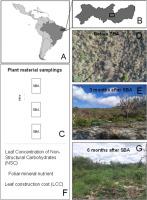Flora ( IF 1.9 ) Pub Date : 2023-12-07 , DOI: 10.1016/j.flora.2023.152436 Ellen Baião , Wanessa S. Carvalho , Fernanda M.P. Oliveira , Jakelyne S. Bezerra , Mariana Santos , Mauro G. Santos

|
Diverse disturbances contribute to biomass loss in tropical dry forests (TDF), of which slash-and-burn agriculture (SBA) may be the most severe; it is practiced by large populations of residents. Plant species capable of resprouting in response to such disturbances often possess above-ground structures that survive and mobilize resources for resprouting, in addition to below-ground structures. In Brazilian TDF, woody species regenerating from stem pieces that persist after SBA events are common. In this study, we evaluated the foliar concentrations of non-structural carbohydrates (NSC) and mineral nutrients during the first six months after an SBA event in all species that resprouted within the experimental area. Almost all the species resprouted exclusively from the stems. The measured nutrient concentrations did not change drastically after an SBA event. Two patterns were observed with respect to NSC concentrations among the species. Half of the studied species exhibited high concentrations of NSC before the SBA event, which gradually decreased three and six months after the disturbance. In contrast, the remaining species maintained consistent NSC concentrations throughout the study period. The cost of building new leaf tissue was similar for all species before the SBA event. However, after disturbance, the species invested different amounts of carbon into the new leaves. Those species that decreased NSC leaf concentration after SBA showed the highest regrowth intensity through the number of new tillers. Our results suggest that the intense translocation of NSC from the leaves before SBA may support the increased activity of the buds present in the remaining stem piece.
中文翻译:

热带干燥林木本植物叶面非结构碳水化合物和再发芽能力
多种干扰导致热带干燥森林(TDF)生物量损失,其中刀耕火种农业(SBA)可能最为严重;大量居民都实行这种做法。除了地下结构之外,能够响应此类干扰而重新发芽的植物物种通常还具有能够生存并调动资源用于重新发芽的地上结构。在巴西 TDF 中,SBA 事件后残留的茎碎片再生的木本物种很常见。在这项研究中,我们评估了 SBA 事件发生后前六个月内实验区域内重新萌芽的所有物种的非结构性碳水化合物 (NSC) 和矿物质营养素的叶面浓度。几乎所有物种都仅从茎中再生。SBA 事件后测得的营养物浓度没有发生显着变化。观察到物种间 NSC 浓度的两种模式。一半的研究物种在 SBA 事件发生前表现出高浓度的 NSC,在干扰后三个月和六个月逐渐下降。相比之下,其余物种在整个研究期间保持一致的 NSC 浓度。在 SBA 事件之前,所有物种构建新叶组织的成本都相似。然而,在受到干扰后,该物种向新叶中投入了不同数量的碳。SBA 后 NSC 叶片浓度降低的物种通过新分蘖的数量表现出最高的再生强度。我们的结果表明,SBA 之前 NSC 从叶子中的强烈易位可能支持剩余茎段中芽的活性增加。



























 京公网安备 11010802027423号
京公网安备 11010802027423号